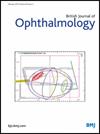Cigarette smoking and retinal ganglion cell layer and photoreceptor outer segment thickness: The Beijing Eye Study.
IF 3.5
2区 医学
Q1 OPHTHALMOLOGY
引用次数: 0
Abstract
PURPOSE To examine an association of cigarette smoking on retinal layer thickness. METHODS The population-based Beijing Eye Study 2011 included 3468 individuals aged 50+ years. All participants underwent optical coherence tomography (OCT) of the macula. Using a multiple-surface OCT segmentation algorithm, the retina was segmented into nine layers. Information about cigarette smoking was assessed in an interview with a standardised questionnaire. The exclusion criterion was the presence of any retinal or optic nerve disease. RESULTS The study included 2173 participants (mean age: 61.7±8.4 years; mean axial length: 23.1±0.8 mm) with 660 (30.4%) participants with a smoking history and 1513 (69.6%) non-smokers. Mean duration of the smoking period was 8.7±14.9 years, and mean smoking quantity was 9.5±18.2 pack-years. In multivariable analysis, higher prevalence of smoking was associated with thinner whole retina (p=0.024; B=-1.64; 95% CIs -3.07 to -0.22), thinner ganglion cell layer (GCL) (p=.044; B=-0.39; 95% CI -0.78 to -0.01) and thinner photoreceptor outer segment layer (POS) (p=0.024; B=-0.38; 95% CI -0.72 to -0.05) with adjustments of age, gender, axial length, education level and hypertension. Similar results were obtained if the retinal thickness measurements were obtained in the various macular subfields. A longer period of smoking was related to thinner whole retina (p=0.009; B=-0.06; 95% CI -0.10 to -0.01), thinner retinal nerve fibre layer (RNFL) (p=0.011; B=-0.01; 95% CI -0.02 to -0.002), thinner GCL (p=0.006; B=-0.02; 95% CI -0.03 to -0.01) and thinner POS (p=0.025; B=-0.01; 95% CI -0.02 to -0.001) with adjustments of age, gender, axial length, education level and hypertension. Higher smoking pack-years were significantly associated with thinner GCL (p=0.022; B=-0.01; 95% CI -0.02 to -0.002). CONCLUSIONS Smoking was related to thinner GCL and POS in this population-based investigation, pointing towards and agreeing with an association between smoking and optic nerve damage or age-related macular degeneration.吸烟与视网膜神经节细胞层和光感受器外段厚度的关系:北京眼研究。
目的探讨吸烟与视网膜层厚度的关系。方法2011年北京眼科研究纳入3468例50岁以上人群。所有参与者都接受了黄斑光学相干断层扫描(OCT)。采用多面OCT分割算法,将视网膜分割成9层。有关吸烟的信息是通过标准化问卷采访评估的。排除标准是存在任何视网膜或视神经疾病。结果研究纳入2173名参与者(平均年龄:61.7±8.4岁,平均轴长:23.1±0.8 mm),其中660名(30.4%)有吸烟史,1513名(69.6%)不吸烟。平均吸烟时间为8.7±14.9年,平均吸烟量为9.5±18.2包年。在多变量分析中,吸烟的高患病率与全视网膜变薄(p=0.024; B=-1.64; 95% CI -3.07 ~ -0.22)、神经节细胞层(GCL)变薄(p= 0.044; B=-0.39; 95% CI -0.78 ~ -0.01)和光感受器外段层(POS)变薄(p=0.024; B=-0.38; 95% CI -0.72 ~ -0.05)相关,与年龄、性别、轴长、文化程度和高血压相关。如果在不同的黄斑亚场中获得视网膜厚度测量,则得到类似的结果。吸烟时间越长,视网膜整体变薄(p=0.009; B=-0.06; 95% CI -0.10 ~ -0.01)、视网膜神经纤维层(RNFL)变薄(p=0.011; B=-0.01; 95% CI -0.02 ~ -0.002)、GCL变薄(p=0.006; B=-0.02; 95% CI -0.03 ~ -0.01)、POS变薄(p=0.025; B=-0.01; 95% CI -0.02 ~ -0.001)与年龄、性别、轴长、文化程度和高血压相关。较高的吸烟包年与较薄的GCL显著相关(p=0.022; B=-0.01; 95% CI -0.02 ~ -0.002)。结论吸烟与GCL和POS变薄有关,表明吸烟与视神经损伤或年龄相关性黄斑变性之间存在关联。
本文章由计算机程序翻译,如有差异,请以英文原文为准。
求助全文
约1分钟内获得全文
求助全文
来源期刊
CiteScore
10.30
自引率
2.40%
发文量
213
审稿时长
3-6 weeks
期刊介绍:
The British Journal of Ophthalmology (BJO) is an international peer-reviewed journal for ophthalmologists and visual science specialists. BJO publishes clinical investigations, clinical observations, and clinically relevant laboratory investigations related to ophthalmology. It also provides major reviews and also publishes manuscripts covering regional issues in a global context.

 求助内容:
求助内容: 应助结果提醒方式:
应助结果提醒方式:


